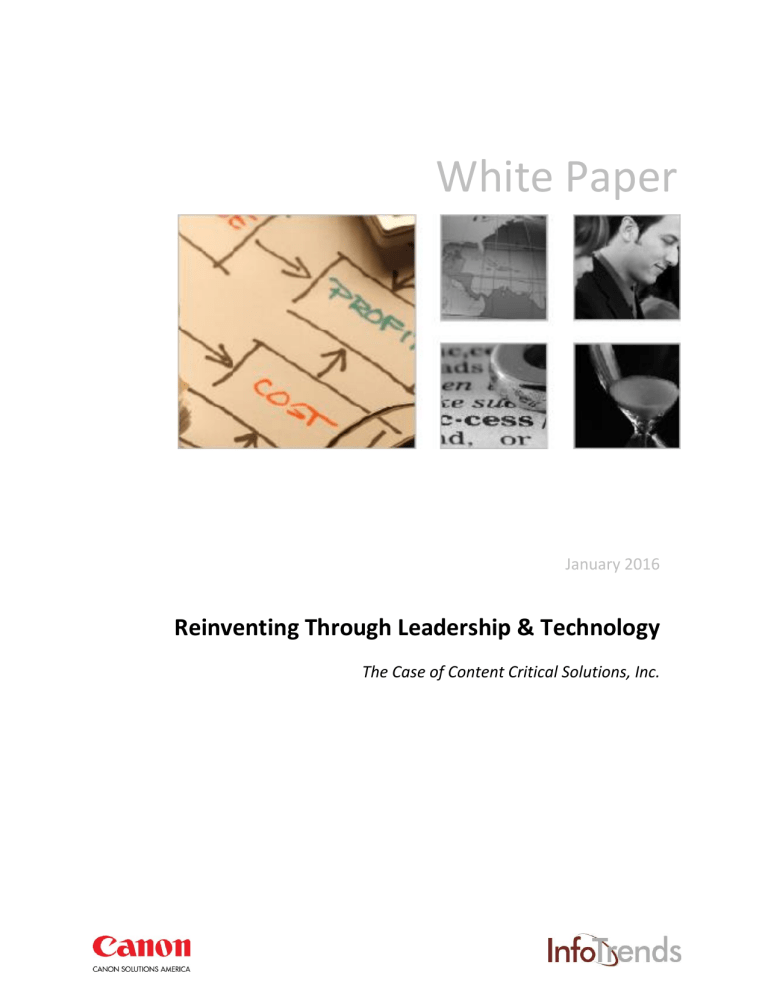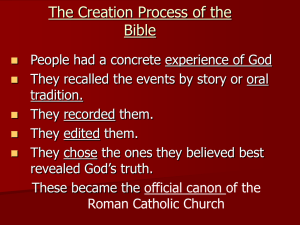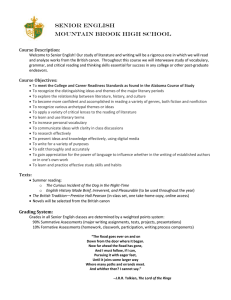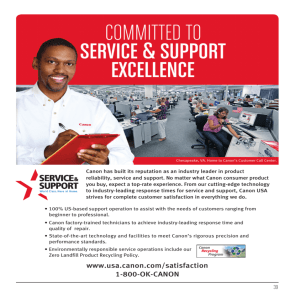White Paper

White Paper
January 2016
Reinventing Through Leadership & Technology
The Case of Content Critical Solutions, Inc.
WHITE PAPER Content Critical: Reinventing Through Leadership & Technology
Table of Contents
Introducing a White-Paper-In/Full-Color-Out Workflow ............................................ 9
List of Figures
© InfoTrends 2
WHITE PAPER Content Critical: Reinventing Through Leadership & Technology
Executive Summary
According to author Josh Linkner in his book entitled “The Road to Reinvention,” one of the most common—yet easily avoidable—reasons that businesses struggle is the failure to reinvent. Content Critical understood that it needed to continuously reinvent itself in a variety of areas on an as-needed basis to remain successful.
Content Critical took the time to explore where the market was headed and saw a growth opportunity in digital print technology, specifically inkjet.
Rather than attempting to preserve its legacy offset printing business, Content
Critical eliminated offset equipment and migrated to an all-digital infrastructure.
Content Critical added value to its transactional documents by using color to highlight important areas and including promotional messaging in the document.
Josh Linkner’s book highlights a number of key principles that businesses should follow on the road to reinvention, and Content Critical followed a number of these principles during its own transformation.
Introduction
Nearly every industry is undergoing a major transformation that is being driven by new and emerging technologies, and none has been more heavily impacted than the printing industry. This is only exacerbating the challenges that today’s business owners already face. Josh Linkner’s recently published book entitled The Road to Reinvention: How to
Drive Disruption and Accelerate Transformation provides a clear path for firms that want to transform their business models to achieve success today and in the future.
Linkner notes, “I’ve seen leaders freeze in the face of an oncoming upheaval rather than act because they’re so concerned about the negative consequences of change. They overestimate the resilience of the status quo and underestimate the need for driving innovation.” According to Linkner, businesses can struggle for a variety of reasons, yet one of the most common—and easily avoidable—is failing to reinvent. This whitepaper discusses how Content Critical (Moonachie, NJ) recognized the need for change and took the necessary steps to remain competitive in today’s evolving industry.
© InfoTrends 3
WHITE PAPER
© InfoTrends
Content Critical: Reinventing Through Leadership & Technology
About Content Critical
Content Critical is a provider of mission-critical business communications and services. The company offers custom solutions for transaction processing, including content management, compliance messaging, and reporting capabilities (e.g., composition and rendering for institutions that require distribution of compliance documents). Content Critical also provides its blue chip Fortune 500 client base with professional services (e.g., programming and development, Web development, graphic design, and prepress), production services (e.g., digital print, wide format output, mailing & fulfillment, commercial print, and binding and finishing), and online support and client services.
The Reinvention Process
Back in 2008, Content Critical was feeling the effects of the economic downturn from the recession that was plaguing the entire printing industry. The company was under constant pressure to drive down its prices even as material and labor costs were increasing. The compliance documents that Content Critical produced were deemed as a cost that was under constant price pressure, and e-delivery was reducing printing volumes. Chief Operating Officer Fred Van Alstyne and Chief Technology Officer John
Slaney realized that things were not going to get better on their own. According to Van
Alstyne, “It was time to change our strategic direction and become more focused on differentiating the products, services, and solutions that we offered. We needed to identify higher-margin opportunities while remaining the most cost-effective supplier.
We completely transformed our business model.” Although Van Alstyne and Slaney didn’t read Linkner’s book prior to their reinvention journey, they did manage to follow all of its key principles, which included letting go of the past, understanding the business justification of key investment decisions, having a willingness to re-tool existing products in favor of new higher-margin solutions, having the willpower to retool operations, and relaunching the company.
Let Go of the Past
Van Alstyne and Slaney realized that a traditional offset business model was a direction that they no longer wanted to pursue. This meant that they had to abandon the beliefs that they had held for years and venture into uncharted waters. The Content Critical management team took the time to explore where the market was headed and saw a growth opportunity in digital print technology, specifically inkjet. According to
InfoTrends’ data, production digital inkjet technology represents the fastest-growing segment of the market. Global digital inkjet print production volume totaled about 180 billion impressions in 2014 and is expected to exceed 500 billion by 2019, demonstrating a compound annual growth rate (CAGR) of nearly 24%.
4
WHITE PAPER Content Critical: Reinventing Through Leadership & Technology
Figure 1: Global Production Color Inkjet Volume
Duty Cycle: <1 Million Impressions Annually
600
Black & White Color
400
23.7%
CAGR
200
© InfoTrends
0
2014 2015 2016 2017 2018 2019
Source: Global Production Printing & Copying Market Forecast: 2014-2019 , InfoTrends 2015
Understand the Business Justification
Content Critical understood the magnitude of its inkjet investment. In addition to transforming its printing methods, the transition would alter workflow, the sales process, and the overall value proposition that the company was delivering to its customers.
Content Critical knew that this wasn’t a field of dreams, and the executives took the time to analyze the business opportunity. Based on its customer base, the firm identified ample volume to justify the investment. Some of Content Critical’s action items included:
Migrating short-run offset work to digital print
Instituting a “white-paper-in/full-color-out” workflow that replaces offset preprinted forms and monochrome digital laser imprinting with full color inkjet
Displacing black & white roll-fed toner-based devices
Identifying completely new application opportunities
Re-tooling legacy software tools to support “full color” workflows
Be Willing to Cannibalize Your Own Products
Content Critical recognized the need to adapt to its customers’ rapidly-changing demands and the market’s evolving opportunities. Customers wanted shorter runs, electronic distribution, and personalization. Rather than attempting to preserve its offset printing business, Content Critical eliminated offset equipment and migrated to an all-digital production infrastructure. The company built out a new portfolio of services that
5
WHITE PAPER Content Critical: Reinventing Through Leadership & Technology incorporated cross-media, complex variable data, database management, content management, web access, and production capability.
Retool Operations
According to Linkner’s book, operational innovation is the concept of completely overhauling the way that a company does business to create a competitive advantage. In essence, this strategy rewrites the rules of the game. Content Critical took this approach when transforming its business. Canon Solutions America had been a long-term and valued partner for Content Critical, so it was the logical partner of choice when the company reinvented itself and made major investments in the latest printing, finishing, and software technologies. One of the first steps was replacing its roll-fed black & white toner devices.
Content Critical: Retooling Production Operations
Content Critical has taken on the challenge of overhauling its print production operations and making them fit into its new portfolio of services. The company acknowledged that the keys to this process include smarter management of print resources, accelerated response rates, unified work processes, converging data streams, and ensuring that the right information gets to the right person at the right time. Content Critical and Canon
Solutions American joined forces in their journey to achieve production excellence.
From Black & White Toner to Full-Color Inkjet Printing
Content Critical added value to its transactional documents by using color to highlight important areas and including promotional messaging in the documents. The company invested in a Canon Océ ColorStream 3500 high-production full color digital roll-fed inkjet printer with the “color-centric” versions of Canon PRISMAproduction and GMC
Inspire software. This printing device includes the option to use an additional fifth or sixth printhead. This gave Content Critical the ability to print security documents by adding MICR 1 in a single pass.
Figure 2: The Canon Océ ColorStream 3500
© InfoTrends
1 Magnetic Ink Character Recognition (MICR) is a machine readable technology commonly used for checks.
Implementions of MICR are based on magnetic toner or ink.
6
WHITE PAPER
© InfoTrends
Content Critical: Reinventing Through Leadership & Technology
As Content Critical began to shift from toner-based production to full color inkjet-based production, it was confronted with the many technological and process challenges that come with the transition to full-color inkjet printing. The Canon TrueSupport program helped the company to master these challenges and significantly accelerated the learning curve for Content Critical. Through this program, Content Critical gained access to a broad range of services that ensured a fast and smooth transition process, including:
Start-to-Finish Project Management Services: Access to a Canon Solutions
America technology team headed by a dedicated project manager that handled the entire installation process.
Implementation and Installation Services: Technical support and access to
Canon’s best practices through site surveys to prepare the site for all physical and environmental requirements; workflow surveys to capture all aspects of future workflow, color management, and organizational needs; hardware and software installation and any necessary pre/post equipment integration; paper selection and testing; and training the production staff on the new printing solution.
Color Management Training and Services: Access to dedicated color specialists that assisted in analyzing and reviewing Content Critical’s current color management system and advised on the necessary tools and training to calibrate Content Critical’s new printing solution and keep it running at peak performance.
In addition to TrueSupport, Canon Solutions America’s field, headquarters, and solutions development resources provide integration services as required to ensure that core Canon
PRISMA, third-party solutions, and Content Critical’s legacy architecture operate as a cohesive solution as opposed to independent silos of technology.
Mastering Color, Substrates, and Inkjet Technology
A key challenge in adopting full-color inkjet printing is being able to accurately estimate printing costs. Inkjet is capable of providing very good quality levels, and yet the cost of the resulting print is closely tied to the consumption of ink—unlike offset where much of the technology cost is built into the printing plates. This means that higher-coverage inkjet jobs cost more to produce than lower-coverage jobs. Having insight and control over this process is crucial in full-color inkjet printing so that users can price their jobs accurately.
Canon’s TrueProof software is an on-screen WYSIWYG (What You See Is What You Get) proofing solution that provides pixel-precise soft-proofing. TrueProof software makes it possible to view images on-screen exactly as they will print because it is based on the same software as Canon’s Océ controllers. Its pixel count capabilities enable an accurate estimation of average color coverage before printing. With Canon’s Ink Control—a
Canon PRISMAproduction module—the actual color coverage of the printed job can be captured after printing. These software tools help enable Content Critical to gain insight and control over pricing and secure its margins.
7
WHITE PAPER Content Critical: Reinventing Through Leadership & Technology
A New Way of Working
The introduction of full-color inkjet printing also brought more complexity to Content
Critical’s printing operations. There are many different media options in use for digital inkjet printing today—light versus heavy weights, coated versus uncoated papers, and glossy versus matte finishes. Some jobs may require only black ink, while others will require the full process color set. Some may need MICR or a spot color. In addition, customer requirements for shorter runs and quicker turnarounds mean that process automation is critical.
A first-in-first-out (FIFO) print production approach, which is the de facto standard for high-productivity toner-based print production, is not well-suited for these new conditions. A FIFO approach aims to get jobs to the printer as early as possible to maximize the utilization of the print device. Because there are multiple paper trays in cutsheet devices, a variety of jobs with varying specifications can be run through the machine. In a roll-fed inkjet environment, jobs using the same stocks need to be aggregated to minimize stock changes and optimize machine throughput.
Canon Solutions America has addressed this workflow concern by introducing a
“Planning Mode” in version 5.04 of PRISMAproduction. This mode makes it possible to group jobs with similar characteristics into batches. These characteristics can be based on media attributes, color requirements, special effects (like MICR or spot colors), service license agreements, type of production line (e.g., inline versus nearby versus offline finishing), or a combination of factors. The planning mode in PRISMAproduction provides a central queue that identifies all job characteristics and makes it easier to sequence the work, the deadlines, and any other requirements.
Figure 3: Canon PRISMAproduction in Planning Mode
© InfoTrends
Source: Canon Solutions America; Screen Image Simulated
8
WHITE PAPER
© InfoTrends
Content Critical: Reinventing Through Leadership & Technology
The planning mode enables a company like Content Critical to organize its production operations such that paper changes are minimized, offline finishing processes are optimized, and print jobs with similar media attributes are grouped together. All this ensures that equipment is used to its maximum potential.
Introducing a White-Paper-In/Full-Color-Out Workflow
Preprinted forms and the associated stock inventory represent another critical area. With its toner-based print production, Content Critical used to have preprinted shells with static content like logos, tints, and other design elements. These preprinted forms would be produced on an offset press and warehoused until needed. The variable content would then be added using digital toner-based monochrome printers. This two-step process was the standard for many years, but it requires warehousing and management of the preprinted forms. If a logo changes or a design alteration is requested, the preprinted forms become obsolete. In addition, there is no flexibility in the use of color. With fullcolor digital printing technology, the static color content and monochrome variable content can be printed in a single pass. To do this, the color elements on the preprinted forms need to be moved over for production on the color inkjet device. This might sound simple, but it is no easy task for service providers like Content Critical with many customers and a wide variety of print applications.
Once again, Content Critical turned to Canon Solutions America to help with this conversion process. The “Preprinted Forms” function of Canon’s PRISMAproduction software helped speed up this process significantly. For each preprinted stock, a PDF equivalent is loaded as a resource into the PRISMAproduction resource library. When an application requires a specific preprinted form, it dynamically pulls the right PDF from the library and automatically merges it with the monochrome variable print data. Content
Critical’s physical stock inventory of preprinted forms was transformed into a digital storage containing all of the required designs, greatly simplifying logistics and freeing up expensive floor space that had been used as warehouse space for the forms.
Flexibility and Performance Application Manufacturing
A critical component in a white-paper-in/full-color-out workflow is the generation of print data streams. During its initial move from offset to monochrome printing with preprinted shells over a decade, Content Critical invested in GMC Software’s PrintNET solution as its de facto standard document composition tool. As a long-standing partner of Canon Solutions America, GMC Software’s new version, called GMC Inspire, expanded its functionality to support not only composition, but fully composed document enrichment/enhancement, colorization and incorporation of CMYK 2 color printing
2 CMYK stands for the process colors of Cyan, Magenta, Yellow, and Black (Key) and refers to a subtractive color model used in color printing.
9
WHITE PAPER
© InfoTrends
Content Critical: Reinventing Through Leadership & Technology standards. This functionality enabled Content Critical to create new color products. There are basically three ways that the company manufactures its applications:
From scratch.
Content Critical accepts variable data from its customers, then performs postal optimization to reduce postage costs and merges the data with predefined templates using GMC Inspire. The Inspire business logic and workflow executes in an automated environment to provide full color output for printing and mailing.
Template-based.
Templates or shells include the creative design of a specific application. These templates are used for frequently recurring print orders, or as a digital preprinted form. In the case of the latter, the “old” toner-based application is converted in GMC Inspire, which leverages the capability of full-color and variable data processing. These overlays are then stored as preprinted-form resources in
Canon’s PRISMAproduction for merging with the black variable data.
Application enrichment.
With GMC Inspire, it is also possible to enrich existing print-ready (i.e., legacy) applications with graphic elements and creative designs or to add/modify production control barcodes for print/post-processing equipment. For example, Content Critical leverages this feature on its high-speed inserting system acquired during the company’s print production workflow overhaul. Using GMC
Inspire, Content Critical adds the necessary Bell and Howell control barcodes on the print application without having to change the application itself.
Canon Solutions America supports Content Critical in its application manufacturing activities by bringing in-depth GMC Inspire subject matter experts to the table. Canon’s
Solutions Development Group and Solutions Consultants advise on and also develop the business logic and workflows within the GMC Inspire software for Content Critical as needed.
Retooling Operations is a Journey, Not a Destination
Content Critical has successfully managed to reinvent itself, but the company is well aware that its chosen path does not end here. To remain successful, Content Critical understands that it must continuously evolve in a variety of areas on an as-needed basis.
One area of expansion relates to the different types of inbound data streams received by
Content Critical from its customers. This shift is occurring as customers move away from old-style legacy data streams. While Content Critical certainly welcomes this additional volume, it must adapt to changing customer needs. Together with Canon Solutions
America and Crawford Technologies (another of Canon Solutions America’s longstanding solution partners), Content Critical has expanded its workflow capabilities to support a wider range of print streams for enrichment and optimization. The Crawford toolset used by Content Critical allows for normalization to a standard input, extraction of customer address information for postal presort and National Change of Address cleansing, and then re-sorting of the print file to help ensure that postal discounts are realized.
10
WHITE PAPER Content Critical: Reinventing Through Leadership & Technology
Content Critical also expanded its Web-To-Print service, which acts as an interface to customers’ end-customers. A Web-to-Print service facilitates outsourcing corporate print management to Content Critical. It also automates ordering, fulfillment, job ticketing, and production management while simplifying order entry for customers and ongoing communications about job status. Offered by Canon Solutions America and one of its partners, Rochester Software Associates (RSA), Content Critical has implemented RSA’s
WebCRD web-to-print software as the foundation for this enhanced service.
Launch Version 2.0
There was one final step in the reinvention process. Content Critical quickly realized that its customers did not understand the values associated with a “white-paper-in/full-colorout” workflow and inkjet’s ability to produce vibrant, full-color, personalized communications. An investment in sales, marketing, and customer education was essential. Content Critical recognized that the right sales team was vital to success. Over the past several months, the company has invested in new salespeople that are capable of supporting a more complex, solutions-oriented sale. Slaney elaborates, “We have also extensively redesigned our marketing materials to better match our service offerings, and we just completed a website redesign. We were slow to get our message out. My suggestion to other business owners is to work on messaging prior to and during the reinvention process.”
© InfoTrends 11
WHITE PAPER Content Critical: Reinventing Through Leadership & Technology
InfoTrends’ Opinion
Josh Linkner’s book states that regardless of the industry you are in, these times can be challenging. If you are willing to take the necessary steps toward reinventing your business, however, the possibilities are truly endless. Van Alstyne notes, “We are experiencing double-digit revenue growth. We have become much more competitive for color logo transactional print runs. We are capturing work from small and medium-sized in-plants as more companies are looking to outsource. This is really an exciting time to be in our business.”
By establishing a strong partnership with Canon Solutions America, Content Critical has successfully navigated the road to reinvention. Just like Linkner recommends in his book,
Content Critical had the foresight to upset the status quo before there was a need to do so.
Now, instead of losing ground, the company has positioned itself as an innovator that is experiencing growth and economic gain.
Canon Solutions America, Inc., a Canon U.S.A. Company, provides industry-leading enterprise, production, and large format printing solutions, supported by exceptional professional service offerings. With the combined technology offerings of Canon and
Océ, Canon Solutions America helps companies of all sizes improve efficiency, be environmentally conscious, and control costs through high volume, continuous feed, digital and traditional printing, and document management solutions. Canon Solutions
America is headquartered in Melville, NY and has offices across the United States.
Learn more at www.csa.canon.com.
This material is prepared specifically for clients of InfoTrends, Inc. The opinions expressed represent our interpretation and analysis of information generally available to the public or released by responsible individuals in the subject companies. We believe that the sources of information on which our material is based are reliable and we have applied our best professional judgment to the data obtained.
Canon is a trademark or registered trademark of Canon, Inc. in the United States and elsewhere. Trademarks for products and services of Canon Solutions America or Canon U.S.A. and trademarks, logos, and service marks and those trademarks, logos, and service marks licensed to Canon USA by Canon, Inc. (collectively, the "Trademarks") displayed in this whitepaper, including but not limited to the Canon logo, are registered and unregistered marks of Canon U.S.A. and
Canon, Inc., as the case may be. Océ is a trademark or registered trademark of Océ-Technologies B.V. in the United States and elsewhere. All other trademarks, trade names, product names, service marks, and all other non-Canon U.S.A. or Océ marks are the property of their respective owners, and are hereby acknowledged. The absence of a product or service name or logo anywhere in the text of this whitepaper does not constitute a waiver of any trademark of other intellectual property rights concerning that name or logo.
© InfoTrends 12
WHITE PAPER Content Critical: Reinventing Through Leadership & Technology
About the Authors
Barb Pellow
Group Director barb.pellow@infotrends.com
+1 781-616-2161
A digital printing and publishing pioneer as well as a marketing expert, Barbara Pellow helps companies develop multi-media strategies. She assists companies in creating strategies to launch new products, building strategic marketing plans, and educating their sales force on delivering value.
David Stabel
Associate Director david.stabel@infotrends.com
+49 176 8448 6057
David Stabel is an Associate Director for InfoTrends’ Customer Communications and
Engagement advisory services. Mr. Stabel is responsible for conducting market research, providing forecast analysis, consulting with clients, and creating editorial content for product and market analysis reports.
Comments or Questions?
© InfoTrends 13





